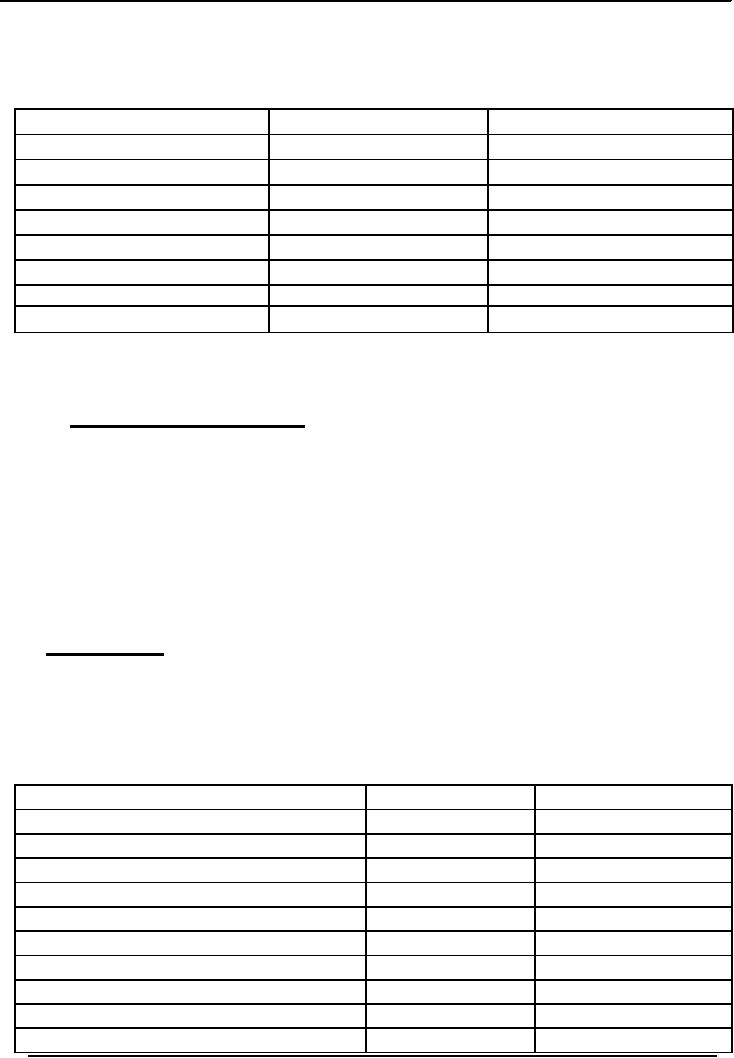 |
Adjusting Entry to record Expenses on Fixed Assets |
| << Business transactions |
| Preparing Financial Statements >> |

Financial
Statement Analysis-FIN621
VU
Lesson-7
ACCOUNTING
CYCLE/PROCESS
(Continued)
e)
Making adjusting entries:
These
are the Entries required for
those transactions which
affect
revenues
or expenses of more than one accounting
period.
Immediate
recording of every event in
some cases is not practical
e.g. raw material,
office
supplies, depreciation. Journal entries of
such expenses are recorded at the end of
accounting
period
and are called adjusting entries.
Regular journal entries (chronological)
are recorded in blue and
adjusting
entries are recorded in red.
Adjusting
Entry to record Expenses on Fixed
Assets
The
expenditure use to acquire Fixed
Assets is spread over a number of
Accounting periods.
The
spreading of that expenditure over a
number of Accounting periods is called
Expense for
that
period.
Adjusting
entry is also required to record Prepaid
Costs.
Expenses
are the expired portion of
Assets.
Office
supplies and Raw material
are treated at the end of Accounting
period.
The
balance of Office supplies & Raw
materials is calculated as follows:
Opening
balance
Add:
Purchases
Less:
Closing
balance
Prepaid
Costs are initially taken as
Asset.
Pre
paid costs, if consumed
entirely during Accounting
period are charged directly
to expense
Types
of Adjusting Entries
i)
Entries
to distribute expenditure benefiting more
than one accounting
period
e.g.
fixed
assets, pre-paid costs (if
for more than one year).
Pre-paid costs are initially
taken
as Asset and
corresponding portion for an
accounting period is reduced there
from. In
the
case of office supplies, raw materials,
the formula is: - opening
balance + purchases-
closing
balance. This would give the
amount/extent of official supplies, raw
materials
consumed
during the accounting period. It
must also be noted that pre
paid costs, if
consumed
entirely during accounting
period, are charged directly
to expense.
Fixed
assets are
those which are used
for more than one Accounting
period.
ii)
Entries
to distribute un-earned revenue i.e. revenue
collected in advance
(deferred
revenue). It is
first recorded as liability, and is
gradually reduced in the
subsequent
accounting
period.
iii)
Entries
to record accrued expenses e.g. unpaid
salaries, interest payable, to be paid
in
the
subsequent accounting
period.
iv)
Entries
to record accrued revenues. These
are first recorded as Assets
i.e. Revenue
Receivable.
For example if rendering of
services/delivery of goods is spread
over a
number of
accounting periods, and billing is to be
done at the completion of
rendering
services
or delivering goods, then corresponding
adjusting entry for each
accounting
period
is made for Revenue Receivable,
but not yet
earned.
29

Financial
Statement Analysis-FIN621
VU
Khizr
Property dealer
Trial
Balance
For
the month of July
2006
Particulars
Rs.
Rs.
Cash
22,500
Accounts
Receivable
9,500
Land
130,000
Building
36,000
Office
Equipment
5,400
Accounts
Payable
23,400
Khizr,
Capital (owner's
equity)
180,000
Total
203,400
203,400
Adjusted
entries are all related to accrual
accounting, as would be seen
from the very description of
each
adjusting
entry given above.
f) Preparing
adjusted trial balance:
This
is the sixth step in Accounting
Cycle. In this, we take into
account the adjusting entries
made
earlier
in step 5 (e).
Adjusting
entries are journalized and posted,
i.e. recorded in journal and
posted in ledger.
Accumulated
depreciation would double
after second month, in the
example of adjusted trial
balance
given above. In the above example,
estimated life of building is taken as 20
years and that
of
office equipment as 10 years,
which makes the monthly
figure of the use of these
assets as
Rs.150
and Rs.45 respectively. Other
transactions during August
2006 changed balances of
cash,
A/Cs
Receivable, A/Cs payable.
Reverting to the earlier reference about
invisible expenses of
Rs.195, in the
Income Statement, these were depreciation
expenses of building amounting to
Rs.150
and
depreciation expenses of office
equipment amounting to
Rs.45.
The
adjusting
entries which
are recorded in Journal at the end of
Accounting period are adjusted
in,
Adjusted
Trial Balance.
Khizr
Property Dealer
Adjusted
Trial Balance
August
31,2006
Particulars
Dr.
Cr.
Cash.
16,105
Accounts
Receivable.
18,504
Land.
130,000
Building.
36,000
Accumulated
depreciation: building.
150
Office
equipment.
5,400
Accumulated
Dep: office
equipment.
45
Accounts
Payable.
23,814
Owner's
equity.
180,000
Sales
commission earned.
10,640
30

Financial
Statement Analysis-FIN621
VU
Advertising
expenses.
645
Salaries
expenses.
7,400
Telephone
expenses.
400
Depreciation
expenses: building.
150
Depreciation
expenses: office
equipment.
45
214,649
214,649
The
above is adjusted trial balance as on
August 31, 2006.
31
Table of Contents:
- ACCOUNTING & ACCOUNTING PRINCIPLES
- Dual Aspect of Transactions
- Rules of Debit and Credit
- Steps in Accounting Cycle
- Preparing Balance Sheet from Trial Balance
- Business transactions
- Adjusting Entry to record Expenses on Fixed Assets
- Preparing Financial Statements
- Closing entries in Accounting Cycle
- Income Statement
- Balance Sheet
- Cash Flow Statement
- Preparing Cash Flows
- Additional Information (AI)
- Cash flow from Operating Activities
- Operating Activities’ portion of cash flow statement
- Cash flow from financing Activities
- Notes to Financial Statements
- Charging Costs of Inventory to Income Statement
- First-in-First - out (FIFO), Last-in-First-Out (LIFO)
- Depreciation Accounting Policies
- Accelerated-Depreciation method
- Auditor’s Report, Opinion, Certificate
- Management Discussion & Analyses (MD&A)
- TYPES OF BUSINESS ORGANIZATIONS
- Incorporation of business
- Authorized Share Capital, Issued Share Capital
- Book Values of equity, share
- SUMMARY
- SUMMARY
- Analysis of income statement and balance sheet:
- COMMON –SIZE AND INDEX ANALYSIS
- ANALYSIS BY RATIOS
- ACTIVITY RATIOS
- Liquidity of Receivables
- LEVERAGE, DEBT RATIOS
- PROFITABILITY RATIOS
- Analysis by Preferred Stockholders
- Efficiency of operating cycle, process
- STOCKHOLDERS’ EQUITY SECTION OF THE BALANCE SHEET 1
- STOCKHOLDERS’ EQUITY SECTION OF THE BALANCE SHEET 2
- BALANCE SHEET AND INCOME STATEMENT RATIOS
- Financial Consultation Case Study
- ANALYSIS OF BALANCE SHEET & INCOME STATEMENT
- SUMMARY OF FINDGINS